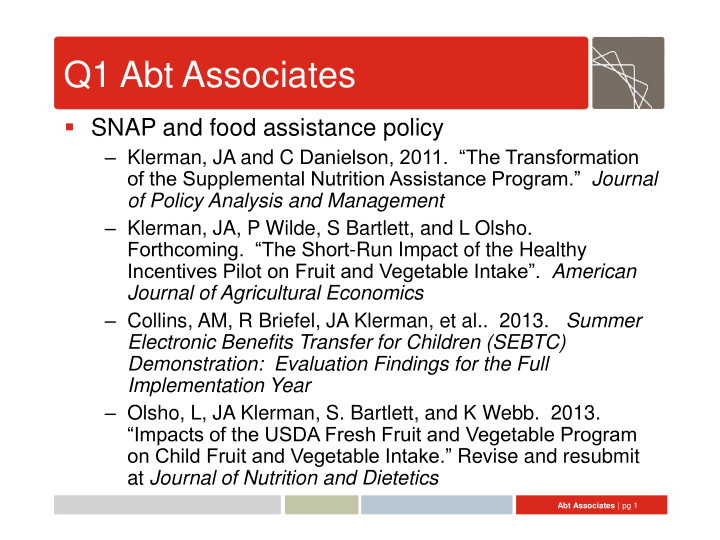



Q1 Abt Associates SNAP and food assistance policy – Klerman, JA and C Danielson, 2011. “The Transformation of the Supplemental Nutrition Assistance Program.” Journal of Policy Analysis and Management – Klerman, JA, P Wilde, S Bartlett, and L Olsho. Forthcoming. “The Short -Run Impact of the Healthy Incentives Pilot on Fruit and Vegetable Intake”. American Journal of Agricultural Economics – Collins, AM, R Briefel, JA Klerman, et al.. 2013. Summer Electronic Benefits Transfer for Children (SEBTC) Demonstration: Evaluation Findings for the Full Implementation Year – Olsho, L, JA Klerman, S. Bartlett, and K Webb. 2013. “Impacts of the USDA Fresh Fruit and Vegetable Program on Child Fruit and Vegetable Intake.” Revise and resubmit at Journal of Nutrition and Dietetics Abt Associates | pg 1
Q1 Abt Associates Pre-TANF welfare reform – Grogger, J. K, L.A. Karoly, and J.A. Klerman. 2002. Consequences of Welfare Reform: A Research Synthesis . Final Report to DHHS-ACF, RAND DRU-2676-DHHS – Hotz, V.J., G. W. Imbens, and J.A. Klerman. 2006. “Evaluating the Differential Effects of Alternative Welfare -to- Work Training Components: A Re-Analysis of the California GAIN Program.” Journal of Labor Economics Abt Associates | pg 2
Q1 Abt Associates Job Search – For DHHS/ACF: Design Options for Search Employment and Follow-on Job Search Assistance Evaluation (Klerman, Jacob, Robin Koralek, Ashley Miller, and Katherine Wen. 2013. “Job Search Assistance Programs: A Review of the Literature.” Abt Associates, Inc. ) – For DOL/CEO: Reemployment and Eligibility Assessment Evaluation (REA) Job Skills Training – For DOL/ETA: H-1B Technical Skills Training, Green Jobs, Transitional Jobs – For DHHS/ACF: Health Profession Opportunity Grants (HPOG), Innovative Strategies for Increasing Self- Sufficiency (ISIS) Abt Associates | pg 3
Q4 Randomization: Yes! Random assignment is (rightly) the “gold standard” – Mimics thought experiment of “impact”; compares outcomes for otherwise identical groups – Not clear that alternatives (i.e., quasi-experimental methods) estimate “impact” (see Hotz, Imbens, and Klerman, 2006) So, why not? – Feasible – Required sample sizes are smaller/cost is lower – Results are easier to explain and less subject to manipulation Abt Associates | pg 4
Q4 Randomization: Details Randomize counties/offices to capture entry effects – For job search programs – Seems unnecessary for job skills training programs Otherwise, this does not seem so complicated or to require special approaches Sample size (and relatedly — program size, data collection strategy) is always an issue – Less so for more intensive programs (e.g., job skills training) – More so for less intensive programs (e.g., job search assistance) – More so for cluster random assignment (e.g., to capture entry effects) Abt Associates | pg 5
Q7 Data Issues Many outcomes are covered by administrative data – e.g., SNAP caseloads/benefit costs, employment/earnings Other outcomes would require a survey – e.g., hunger/food security, other measures of hardship, broader definitions of income Survey costs drive evaluation cost and design – So choice of outcomes is critical – Specifying survey-only outcomes is likely to lead to an under-powered evaluation (i.e., missing important impacts/measuring them very imprecisely) Abt Associates | pg 6
Q9 Structural Issues FNS Issues Proposals Implementation RFA to states RFQ to evaluators Abt Associates | pg 7
Inter-Relation of RFA to States and RFQ to Evaluators FNS Issues Proposals Implementation RFA to States propose states program designs RFQ to Evaluators propose evaluators evaluation designs These proposals are inter-related: States and evaluators need to know the range of possible/allowable designs Abt Associates | pg 8
Inter-Relation of RFA to States and RFQ to Evaluators FNS Issues Proposals Implementation RFA to States propose states program designs RFQ to Evaluators propose evaluators evaluation designs Random assignment needs to be built in ex ante and will affect (sometimes strongly) state implementation Abt Associates | pg 9
Inter-Relation of RFA to States and RFQ to Evaluators FNS Issues Proposals Implementation States implement RFA to States propose their programs states program designs w/evaluation built in Evaluators exploit RFQ to Evaluators propose built in evaluation evaluators evaluation designs features Abt Associates | pg 10
From Bitter Experience, We Know a Lot about this Timeline is tight, so both – RFA to states for programs, and – RFQ to contractors for evaluations … must go out soon But, – States need to know about the nature of the evaluations – Evaluators need to know about the nature of the programs Which is impossible! We hope this session helps with that “ dealock ”! Abt Associates | pg 11
Recommend
More recommend